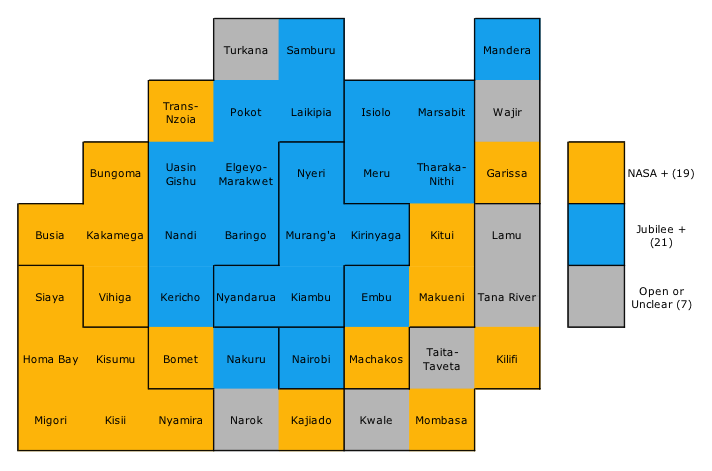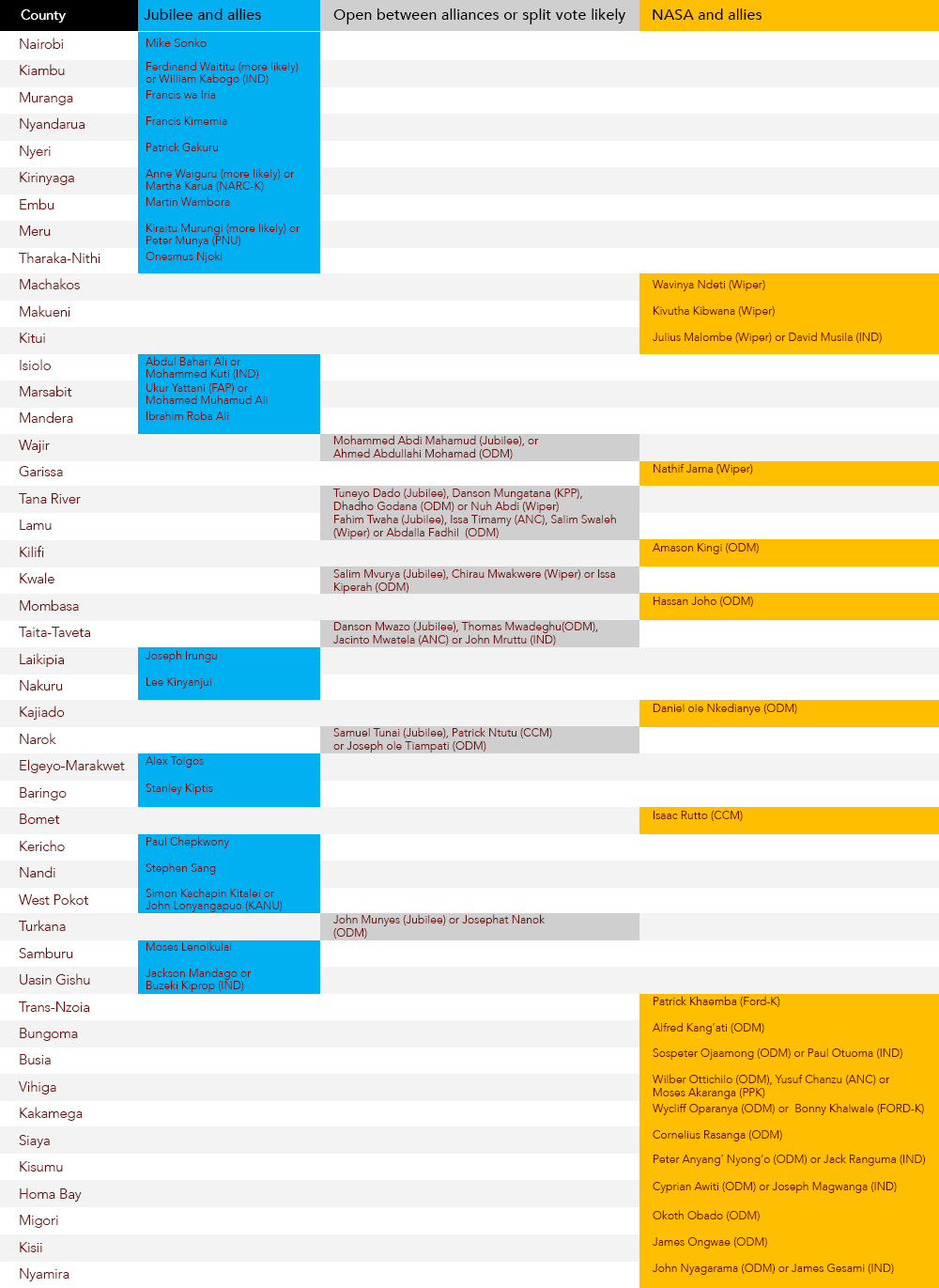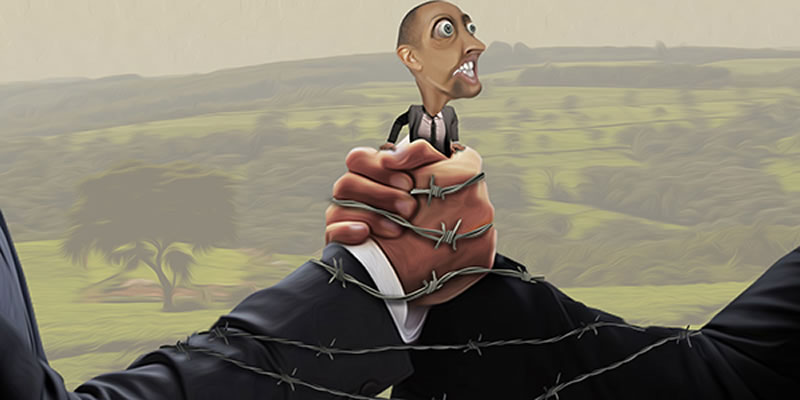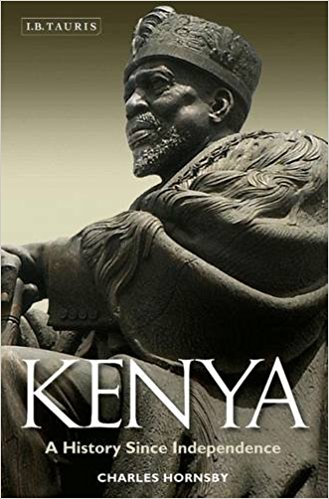This article is the second in a series of three written for The Elephant, following on from the piece released on 28 June 2017, in which I tried to assess the state of play in Kenya’s electoral cycle and made educated (or otherwise) predictions on the results (https://www.theelephant.info/future/2017/06/28/the-numbers-game-predicting-winners-and-losers-in-the-august-2017-poll). The third and final of these articles on Kenya’s upcoming elections will be released just before polling day.
As in my 28 June piece, I’ll start by saying that this is a non-aligned analysis, descriptive rather than campaigning for either side. But it is not static. I update the analysis as circumstances change and my knowledge improves. This update looks at events since mid-June and improves the granularity of some predictions. It also looks specifically at the gubernatorial contests in more detail.
Both alliances are running nationwide programmes of rallies, alternating between attack and defence, parry and riposte, as they campaign in marginals, strike into their opponents’ strongholds and occasionally return home to shore up support.
At the national level the opposition alliance NASA is still doing well and has had the best of the media contest, with strong social media support counteracting a slight alignment for Jubilee (as the party of government) in the mainstream mass media. Both parties are spending fortunes. In Jubilee’s case, its campaign is buttressed by some cabinet secretaries (i.e. government ministers), theoretically non-political presidential appointees and salaried civil servants, who are openly campaigning for the incumbent Uhuru Kenyatta and his deputy William Ruto at public rallies. There is also gentle pressure on the ground from the local administration in some areas. The recent death of Interior Security Cabinet Secretary Joseph Nkaissery will distract and destabilise Jubilee slightly, but is unlikely to affect either process.
Both alliances are running nationwide programmes of rallies, alternating between attack and defence, parry and riposte, as they campaign in marginals, strike into their opponents’ strongholds and occasionally return home to shore up support. Both have capitalised with some success on the key insurgencies mentioned in June. NASA had a spectacular rally in Isaac Rutto’s Bomet (part of Ruto’s Kalenjin heartland) on 1 July, while Uhuru Kenyatta and Ruto led a three-day series of campaign rallies across Ukambani, Kalonzo Musyoka’s home turf, backed by local MPs who have defected to Jubilee. Raila Odinga even campaigned recently in Kenyatta’s home Kiambu without incident. Odinga led a punishing series of 100 rallies nationwide during June, an amazing workload for a 72-year old, though he appears in good health. Both alliances are campaigning for a “six piece suit” in their strongholds (i.e. party ticket voting down the line), though both have faced resistance from voters.
There has been only one national opinion poll released – the Infotrak poll released on 30 June. This was a restricted poll with some methodological questions, sampling only 2,000 voters in 29 counties. But the results tell a consistent story with the previous Ipsos survey – Kenyatta remains ahead by 48% to 43% for Odinga, though with a narrowing gap, a significant number of “undecideds or won’t tells” and less than 1% for all of the other candidates combined.
Despite the Jubilee’s campaign focus on its development achievements (or “growing the cake”), endemic state corruption remains a widespread concern, even amongst supporters. This is the administration’s greatest weak spot, though in truth there is little to suggest that the NASA administration would be any less corrupt once it settles in.
Both parties have also released their manifestos. As Ken Opalo describes in his blog (https://kenopalo.com/2017/07/01/making-sense-of-competing-visions-of-kenya-in-the-jubilee-nasa-manifestos) , on a left-right axis, the Jubilee manifesto is more right-wing (pro-private enterprise, reduced state role, conservative, more stress on security) and the NASA one more left-wing (more state intervention, more language of change and greater effort to create equity of outcomes). But what parties say in their manifestos are only the loosest guide to what they might do in practice and these manifestos, while necessary to maintain the illusion that they are programmatic parties, mean very little electorally. For most of the players and many of the voters, it is as much about who will get to “eat” as how much “cake” there will be.
Despite the Jubilee’s campaign focus on its development achievements (“growing the cake”), endemic state corruption remains a widespread concern, even amongst supporters. This is the administration’s greatest weak spot, though there is little to suggest that the NASA administration would be any less corrupt once it settles in. NASA applied no more ethical criteria on its candidates than did Jubilee. The recent discovery that Jimmy Wanjigi, repeatedly mentioned unfavourably during the Anglo Leasing cases, is now backing NASA, only reinforces the perception that the noses in the trough might change with a NASA win, but the trough will remain the same.
As a result of the latest opinion poll, recent events and feedback from correspondents, I have made a few changes to the model which I used to predict the results in June. I received several messages about specific regions in response to my 28 June article. Some argued that Odinga’s support in Meru was higher than I assessed it to be. I have reviewed the argument but have decided not to change position on this. Odinga made the same claims in 2013, and although NASA clearly has some traction, he has lost local elite support since then, not gained it. Others argued that Kenyatta’s support in Western was significantly higher than I had assessed it to be and that he might get 20%-plus rather than the 10-15% I had assigned him. The May Ipsos poll said the same thing, as does the Infotrak poll, which has Kenyatta at 28% in Western. I have, therefore, slightly increased the Jubilee numbers in a couple of counties, but stayed with the overall view that Jubilee won’t exceed 15% there. I have also increased Odinga’s presidential lead in Nairobi to 53%-47%, buttressed by a small TIFA poll of Nairobi voters in early July, and strengthened NASA’s support slightly in Bomet, Turkana, Lamu and Trans-Nzoia.
Turnout is the key that will decide where the election will be won or lost. In their homelands, voter dissatisfaction for both alliances will be expressed more through reduced turnout than by votes for the other side.
The latest calculations also incorporate the final county-level voter registration figures released by the Independent Electoral and Boundaries Commission (IEBC) on 26 June. Perhaps surprisingly, and confounding conspiracy theorists, this had almost no effect. In the main, the numbers registered fell slightly, as dead voters and duplicates were cleaned. The main exception was in Isiolo and the North-East, where the registered voters grew by 3-4% on the February 2017 numbers, a surprising result from an audit and verification exercise, but it may be due to delays in getting numbers back to Nairobi. The Kisii numbers also grew substantially, but those in the former Central Province fell.
After all these counteracting adjustments, my final prediction is almost unchanged: a Jubilee presidential victory by 53% to 47% (with the other candidates within the 1% rounding) or by 8.6 million for Jubilee to 7.5 million for NASA. There are other models circulating on the Internet and since the first article I have been sent five for comment. Some are grossly incorrect and created for partisan purposes (halving the size of their opponents’ supporters in key areas, for example). Of the two best county-by-county reviews, one argues for an 8.8 million to 7.8 million win for Jubilee and the other for an 8.6 million to 7.7 million win for NASA. No credible model has either alliance close to the “10 million mark” that NASA has set as its aspiration. All the models seen, however, have a key weakness – they assume turnout is constant country-wide, when in previous elections it has differed wildly. In fact, turnout is the key that will decide where the election will be won or lost. In their homelands, voter dissatisfaction for both alliances will be expressed more through reduced turnout than votes for the other side. Apart from a “turnout tsunami”, NASA’s chances for victory seem to depend on keeping Jubilee off-balance, while unearthing and publicising more corruption scandals, and either encouraging an open split in Jubilee, or facilitating the public defection of key Jubilee operatives to NASA.
From the presidency, we turn now to the county level, the most granular level at which it is reasonable to make predictions. In general, members of county assemblies (MCAs), parliamentary seats, women’s representative and senate seats will follow a similar pattern, but it is the 47 gubernatorial contests that have most galvanised politicians and voters as the governors tend to be the leaders of local factional alliances, including candidates for all the other seats.
First though, let’s review what happened in 2013, the first gubernatorial election cycle. Then, CORD did well, better than at other levels of the electoral system, befitting their stance as the strongest supporters of the devolved constitution at the time. Twenty-three governorships (49%) were won by CORD candidates and allies, and 20 (42%) by Jubilee, with 4 (Vihiga, Bungoma, Lamu and West Pokot) won by the Amani coalition or non-aligned candidates. However, many of CORD’s victories were extremely close (their Nyamira Governor, for example, won with only 19% of the vote) and there were several split-ticket results, as three or four serious candidates were contesting.
Compared to 2013, Jubilee will perform slightly better in the governor races, with pro-Kenyatta candidates winning 23 or 24 counties. They are stronger now in Isiolo, Marsabit, Tana River, Wajir and West Pokot than in 2013, though weaker in Narok and Bomet.

Turning to 2017, the country is more polarised than in 2013. From three national alliances we are down to two, with half of the original Amani coalition – Musalia Mudavadi’s Amani National Congress (ANC) – now with NASA and the other half – New FORD-Kenya and KANU – with Jubilee. There are, therefore, fewer marginal seats between the alliances and the main challengers for most ODM and Jubilee governors are internal insurgencies from opponents who lost in the primaries (or were rigged out) and then stood as independents, or who set themselves up beforehand as the candidate for a sister party, while supporting the same faction’s presidential candidate. Jubilee has candidates for governor in 45 of 47 counties, while NASA’s gubernatorial candidates include 27 from ODM, 13 from Wiper, 11 from the ANC, 5 from Chama Cha Mashinani and 4 from FORD-Kenya, plus dozens of local independents.
Compared to 2013, Jubilee will perform slightly better in the governor races, with pro-Kenyatta candidates winning 23 or 24 counties. They are stronger now in Isiolo, Marsabit, Tana River, Wajir and West Pokot than in 2013, though weaker in Narok and Bomet. I predict Mike Sonko will defeat Evans Kidero and Peter Kenneth in Nairobi, though there is a slight pro-Odinga majority in Nairobi. Turkana, I think, will be pro-Jubilee overall but ODM’s Josephat Nanok himself might survive. I think Isaac Rutto will win Bomet, but it will not be a landslide and I believe that Bomet County will vote Rutto-Ruto rather than NASA down the line. With Mudavadi on-side, NASA is stronger now in Bungoma, Trans-Nzoia and Vihiga but may lose one of the governorships in Narok, Kwale, Taita-Taveta or (less likely) Mombasa because of split votes between three strong NASA candidates. Overall, my latest assessment is that they and their allies will also win 23-24 governorships, an extremely close result. (Note that I have decided for clarity to refer to the Bomet Governor as Isaac Rutto as he is often called (rather than “Ruto”, his legal name), to distinguish him from his namesake William.)


There are, therefore, more counties that are uncertain or still in play in the governorships than in the presidency. If NASA wishes to strengthen its hand in these races, it is essential to persuade a dozen or more serious CCM, WIPER, ANC or ODM candidates to stand down and back their NASA colleagues, something they have so far completely failed to do. The list below suggests the most likely winners for NASA and Jubilee and the seats where there is a real competition between alliances.

In the final article of this series we will look at the parliamentary races and try – despite my own advice above – to give some overall “guesstimates” of the parliamentary results.
NASA is stronger now in Bungoma, Trans-Nzoia, Vihiga and Nyamira, but may lose one or more of the governorships in Narok, Kwale, Taita-Taveta or (less likely) Mombasa because of split votes between three strong NASA candidates.
Meanwhile, the IEBC continues to press forward doggedly with its countdown to 8 August, though the sniping against it is unrelenting. It is now hearing seven cases relating to alleged violations of its code of conduct, which could potentially disqualify four MPs and a gubernatorial candidate. As expected though, no one has been disqualified for ethical concerns (how this could happen without conviction in a court of law was always hard to see) and civil servants continue to campaign for Jubilee without sanction.
The IEBC also lost a key lawsuit against its claim to be the sole presidential returning officer; the final presidential tallying will now take place in every constituency and whatever is announced (or rather what is certified in form 34) will be final unless petitioned. This should make the national count less contentious than in 2007 and 2013, though what happens if every party tallies the nationwide results differently (or if what the returning officer announces out loud doesn’t match the form, or there are two or more forms) is worrying. It will further increase the pressure on individual returning officers in the constituencies to “pad” local results at the last minute for the dominant party and may lead to violence in constituency tallying halls. The IEBC has begun printing ballot papers despite allegations of a connection between the Dubai-based Al Ghurair Printing and Publishing and Jubilee. The High Court ruled last week that the IEBC should issue a fresh tender for the printing of presidential ballot papers (though the other five elections were unaffected, a further source of confusion and concern). The IEBC has threatened to appeal this decision and in the meantime is trying to meet the court’s requirement for consultation in a way which might not delay the presidential election. We now face three different possibilities: a last minute recovery through an agreement to continue the current contract to print presidential ballots (or an implausibly speedy replacement tender), an entirely delayed election process, or a split contest, with the presidential election some weeks after the rest, a bizarre but interesting scenario
Meanwhile, the IEBC knows that there are at least 900,000 dead voters on the register, as they were only confident enough to remove 90,000 of the 1.1 million dead adults the KPMG audit estimated were still listed as voters. Instead, they are relying on the biometric (fingerprint and photo) voter identification system to prevent others voting “on behalf of” these dead voters. I have a suspicion that this is over-optimistic and that the biometric system may break down in some homelands, forcing officials to use the paper registers, which while they still contain photos, better permit impersonation. Assuming that the IEBC and KPMG were correct, and there are a million dead people still listed (5% of the register), any turnouts above 90% are practically impossible unless the dead rise for the day.
More broadly, with a month to go, there is a growing sense that this election is the end of an era, and gladly so, and that the political wars between the Kenyatta and Odinga dynasties will soon end. This should allow a less personalised and directly ethnicised form of politics to emerge.
Returning again to the key “what if” question if Odinga loses the presidential election narrowly, there is definitely a risk of violence in Nairobi, Kisumu and potentially elsewhere, and the closer the contest, the more trouble there will be. The IEBC, in my view, is acting reasonably given its mandate and constraints, but NASA’s fear of rigging is so visceral that the commission receives no credit for anything, and if Odinga were to lose narrowly, NASA would certainly cry foul. To do this convincingly, the case against the IEBC needs to be built incrementally over several months, a process which is already underway.
More broadly, with a month to go, there is a growing sense that this election is the end of an era, and gladly so, and that the political wars between the Kenyatta and Odinga dynasties will soon end. This should allow a less personalised and directly ethnicised form of politics to emerge, though, as Susanne Mueller has pointed out, the fear of harm from the “other” if they win power will remain a force for many years to come, especially amongst the Kikuyu and the Luo.
Where Kenya’s new leadership will arise from, however, is not yet clear. Most of the current second-tier leaders are elderly, and apart from 50-year old William Ruto, there are few obvious up-and-coming successors. And this assumes that “Mount Kenya” will accept the retirement of their gladiatorial champion. If Kenyatta is victorious, will community leaders not agitate in 2020-1 for a constitutional amendment to change the two-term presidential limit, another “change-the-constitution” movement like that of 1976-7, again designed to prevent a Kalenjin acceding to the throne? Heir-apparent Ruto is fighting wars on two fronts now – the first to win the election with his Kikuyu partners, the second, to secure his succession from those partners. Neither are easy contests.
Charles Hornsby is the author of Kenya: A History since Independence.
He lives in Ireland.






